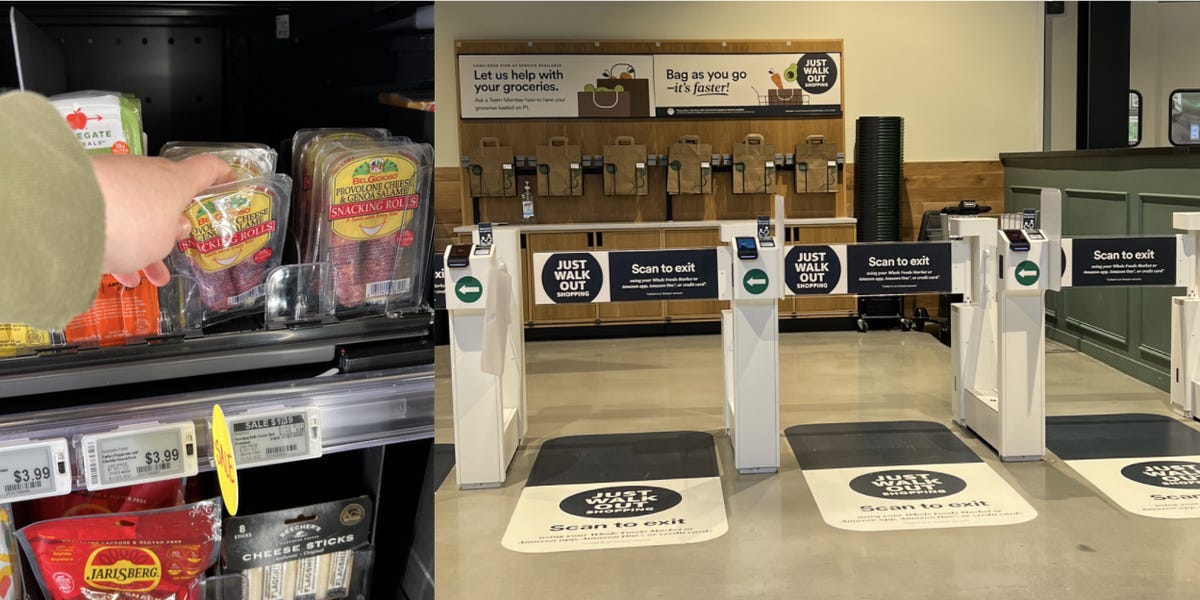Amazon’s “Just Walk Out” technology is a cashierless system that allows shoppers to scan an in-app QR code or use Amazon One to enter and exit a store and pay for goods.
Source: Amazon
Amazon’s “Just Walk Out” technology is a cashierless system that allows shoppers to scan an in-app QR code or use Amazon One to enter and exit a store and pay for goods.Amazon One is a biometric technology that uses a person’s palm print for payment. The system was launched in September 2020 at the company’s Fresh stores. Shoppers who do not want to use their palm can use the QR code.The palm-scanning system is distinct from Just Walk Out because it is simply an innovative way to pay.Meanwhile, Just Walk Out uses motion sensors to track which items shoppers pick up and charge them accordingly when they exit, meaning they don’t have to stop at a register.The first Whole Foods with Just Walk Out is in Washington DC at Glover Park and opened in February 2022.I tried the unique system in 2022 and was impressed that I could use my palm to pay, but found a few issues with the overall experience.When I first got to the store, I had to sign up for Amazon One, though it is not the only payment option. Other methods include scanning an in-store code from the Whole Foods Market or Amazon app or paying at self-checkout.It took a few tries, but I finally got my palm scanned and linked to my credit card. You must have an Amazon account to use Just Walk Out but do not need one to use self-checkout.I entered the store by scanning my palm again at the entrance labeled “Just Walk Out.” Customers who do not want to use the cashier-less system can enter through a separate gate and pay at the register.Once inside, I was initially confused about how to ensure the store knew which items I was picking up, but an employee explained that there are hundreds of motion sensors that track shopper movements.I was told to shop as normal and that the sensors next to the food and hanging from the ceiling would record what I wanted to buy, which seemed easy enough.However, the employee said to pay attention to where I grab items from. Apparently, a lot of food, particularly in the produce section, is weight-controlled.For example, the store recognizes when I pick up an orange because the weight goes down. If I decide I don’t want that orange anymore, I need to put it back in the exact same bin or the store will still charge me, according to the employee.I reached out to Amazon to see if this was true, and a company spokesperson said “Just Walk Out technology is highly accurate” and “items a customer picks up but decides not to purchase can be put back on any shelf and they will not be charged. ““On rare occasions where a customer may find a discrepancy on their receipt, they can easily request a refund through the app or reach out to customer service via email and a team member will be able to assist them,” they continued.After making a mental note to remember where I picked an item up from, I eventually settled on some raspberries and then made my way to the aisles.Almost every item in the store had a sensor next to it, including hair products and even Hydro Flask bottles.In the drink aisle, I found my all-time favorite bottled tea, Ito En’s green tea, which is a popular Japanese brand.I also grabbed a salami and provolone snack pack before heading to the deli.After scouting out the area, I realized there were not any sensors next to the food. So, I asked the employee for a small package of cheese, which she scanned and handed to me.According to the worker, when she scanned the cheese, one of the ceiling sensors was activated and told to turn towards me to record my purchase. The store scanning my every move was a little off-putting, but I guess that’s what I signed up for.Moving on to dairy, I searched the refrigerators for a specific protein bar I knew was available at Whole Foods. I eventually found the Perfect Bar flavor I wanted and headed to the hot foods section.For hot foods, there are two fixed-priced sizes shoppers can choose from — small for $9.99 and large for $14.99. Sensors track which size customers get and charge them accordingly.Shoppers should pack as much food as possible in the containers since the price is not based on weight.I ended up not getting any hot food and instead headed to the Just Walk Out exit.To use the lane, I simply scanned my palm above the sensor and was on my way.Self-checkout is located next to the Just Walk Out lane and at the front of the store for people who prefer to use a register.Because the expedited exit is at the back of the store, I had to walk through the entire building to leave, but I did not have to scan my palm again.My receipt was available in the Amazon app. To find it, navigate to “Your Orders” and filter “Local Store Orders,” where you can review the items you purchased and the total cost.I was surprised to see the protein bar was not recorded, so I ended up getting the food for free by accident.Overall, I noticed two main, but opposite issues — customers could either pay for an item they didn’t leave with because they returned it to the wrong bin, or they could get free food due to a sensor malfunction.
Amazon One is a biometric technology that uses a person’s palm print for payment. The system was launched in September 2020 at the company’s Fresh stores. Shoppers who do not want to use their palm can use the QR code.
Source: Amazon
The palm-scanning system is distinct from Just Walk Out because it is simply an innovative way to pay.
Source: CNBC
Meanwhile, Just Walk Out uses motion sensors to track which items shoppers pick up and charge them accordingly when they exit, meaning they don’t have to stop at a register.
Source: Insider
The first Whole Foods with Just Walk Out is in Washington DC at Glover Park and opened in February 2022.
Source: Insider
I tried the unique system in 2022 and was impressed that I could use my palm to pay, but found a few issues with the overall experience.
When I first got to the store, I had to sign up for Amazon One, though it is not the only payment option. Other methods include scanning an in-store code from the Whole Foods Market or Amazon app or paying at self-checkout.
It took a few tries, but I finally got my palm scanned and linked to my credit card. You must have an Amazon account to use Just Walk Out but do not need one to use self-checkout.
Source: Amazon
I entered the store by scanning my palm again at the entrance labeled “Just Walk Out.” Customers who do not want to use the cashier-less system can enter through a separate gate and pay at the register.
Once inside, I was initially confused about how to ensure the store knew which items I was picking up, but an employee explained that there are hundreds of motion sensors that track shopper movements.
I was told to shop as normal and that the sensors next to the food and hanging from the ceiling would record what I wanted to buy, which seemed easy enough.
However, the employee said to pay attention to where I grab items from. Apparently, a lot of food, particularly in the produce section, is weight-controlled.
For example, the store recognizes when I pick up an orange because the weight goes down. If I decide I don’t want that orange anymore, I need to put it back in the exact same bin or the store will still charge me, according to the employee.
I reached out to Amazon to see if this was true, and a company spokesperson said “Just Walk Out technology is highly accurate” and “items a customer picks up but decides not to purchase can be put back on any shelf and they will not be charged. “
“On rare occasions where a customer may find a discrepancy on their receipt, they can easily request a refund through the app or reach out to customer service via email and a team member will be able to assist them,” they continued.
After making a mental note to remember where I picked an item up from, I eventually settled on some raspberries and then made my way to the aisles.
Almost every item in the store had a sensor next to it, including hair products and even Hydro Flask bottles.
In the drink aisle, I found my all-time favorite bottled tea, Ito En’s green tea, which is a popular Japanese brand.
I also grabbed a salami and provolone snack pack before heading to the deli.
After scouting out the area, I realized there were not any sensors next to the food. So, I asked the employee for a small package of cheese, which she scanned and handed to me.
According to the worker, when she scanned the cheese, one of the ceiling sensors was activated and told to turn towards me to record my purchase. The store scanning my every move was a little off-putting, but I guess that’s what I signed up for.
Moving on to dairy, I searched the refrigerators for a specific protein bar I knew was available at Whole Foods. I eventually found the Perfect Bar flavor I wanted and headed to the hot foods section.
For hot foods, there are two fixed-priced sizes shoppers can choose from — small for $9.99 and large for $14.99. Sensors track which size customers get and charge them accordingly.
Shoppers should pack as much food as possible in the containers since the price is not based on weight.
I ended up not getting any hot food and instead headed to the Just Walk Out exit.
To use the lane, I simply scanned my palm above the sensor and was on my way.
Self-checkout is located next to the Just Walk Out lane and at the front of the store for people who prefer to use a register.
Because the expedited exit is at the back of the store, I had to walk through the entire building to leave, but I did not have to scan my palm again.
My receipt was available in the Amazon app. To find it, navigate to “Your Orders” and filter “Local Store Orders,” where you can review the items you purchased and the total cost.
I was surprised to see the protein bar was not recorded, so I ended up getting the food for free by accident.
Overall, I noticed two main, but opposite issues — customers could either pay for an item they didn’t leave with because they returned it to the wrong bin, or they could get free food due to a sensor malfunction.
Read the full article here





